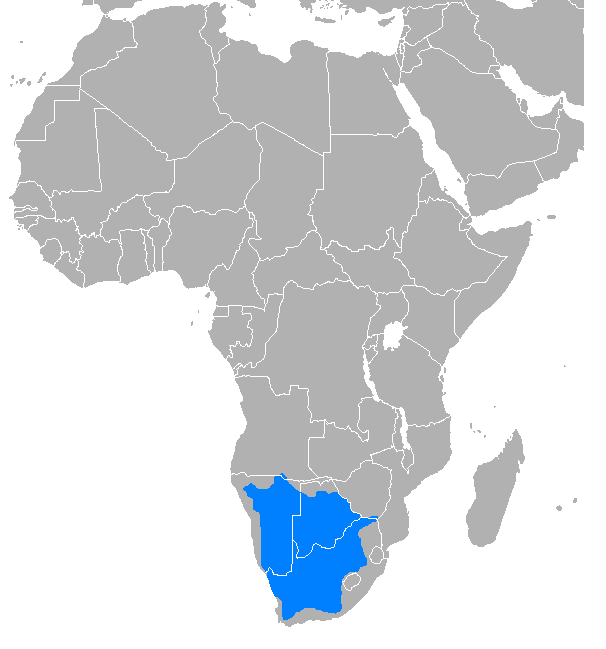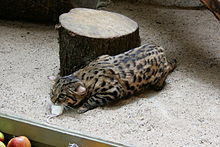
Taxonomy
The black-footed cat is a member of the genus Felis.[1] It was first described by English naturalist William John Burchell in 1824.[4]Two subspecies have been nominated:[1]
- F. n. nigripes Burchell, 1824 occurs in Namibia, Botswana and in the provinces of Mpumalanga, Gauteng, Northwest Province and Northern Cape in South Africa
- F. n. thomasi Shortridge, 1931 described on basis of skins from Botswana and Griqualand West.[5]
The following cladogram shows the phylogenetic relationships of black-footed cat and other species within the Felis lineage. [7]
| |||||||||||||||||||||||||||||||
Characteristics
Close-up of a black-footed cat at the Wuppertal Zoo
Despite its name, only the pads and underparts of the cat's feet are black. The cat has a stocky build with rounded ears, large eyes, and short black-tipped tail. The fur varies in color from cinnamon-buff to tawny, and is patterned with black or brown spots that merge to form rings on the legs, neck, and tail. These patterns provide the animals with camouflage; the backs of their ears, however, are the same color as the background color of their fur. They have six mammae, and unlike other spotted cats, non-pigmented skin.[10]
Distribution and habitat
The black-footed cat is endemic to southern Africa, and primarily found in South Africa, Namibia, marginally into Zimbabwe, and likely in extreme southern Angola. Only historical but no recent records exist in Botswana. It lives in dry, open savanna, grassland and Karoo semidesert with shrub and tree cover at altitudes up to 2,000 m (6,600 ft), but not in the driest and sandiest parts of the Namib and Kalahari Deserts.[2] During the night, they need sparse shrub and tree covers to hunt but spend the daytime in burrows or empty termite mounds.[10][11]Ecology and behavior
Adult black-footed cat resting
Black-footed cat in cover
They are typically found in dry, open habitat with some degree of vegetation cover. Apparently they get all the moisture they need from their prey, but will drink water when available.[8]
Unlike most other cats, black-footed cats are poor climbers, and will generally ignore tree branches. Their stocky bodies and short tails are not conducive to tree-climbing.[12] They dig vigorously in the sand to extend or modify burrows for shelter.[10]
Black-footed cats are highly unsociable animals that seek refuge at the slightest disturbance. When cornered, they are known to defend themselves fiercely. Due to this habit and their courage, they are called miershooptier (anthill tiger in Afrikaans) in parts of the South African Karoo. They rarely use termite mounds for cover or for bearing their young. A San legend claims that a black-footed cat can kill a giraffe by piercing its jugular. This exaggeration is intended to emphasize the bravery and tenacity of the animal.[13] The only times their solitary behavior changes is during breeding season, and among females with dependent kittens.[3][10]
A female roams in an average home range of 10 km2 (3.9 sq mi) in a year, and a resident male of 22 km2 (8.5 sq mi). The range of an adult male overlaps the ranges of one to four females.[3] On average, an adult animal travels 8 km (5.0 mi) per night in search of prey. The cats use scent marking throughout their ranges, with males spraying urine up to twelve times an hour. Other forms of scent marking include rubbing objects, raking with claws, and depositing faeces in visible locations. Their calls are louder than those of other cats of their size, presumably to allow them to call over relatively large distances. When close to each other, however, they use quieter purrs or gurgles, or hiss and growl if threatened.[10]
Diet and hunting
Captive black-footed cat with a mouse
Black-footed cats hunt mainly by stalking, rather than ambush, using the cover of darkness and all available traces of cover to approach their prey before the final pounce. They have been observed to hunt by moving swiftly to flush prey from cover, but also to stalk slowly through tufts of vegetation. Less commonly, they wait outside rodent burrows, often with their eyes closed, but remaining alert for the slightest sound.[6] In common with the big cats, but unlike most other small species, black-footed cats have been observed to hide some of their captured prey for later feeding, rather than consuming it immediately.[14][10]
Reproduction and lifecycle
Black-footed cats have lived for ten years in captivity. Females reach sexual maturity after eight to twelve months. They come into estrus for only one or two days at a time, and are receptive to mating for a few hours, requiring males to locate them quickly. Copulation occurs frequently during this period. Gestation lasts from 63 to 68 days. A litter consists usually of two kittens, but may vary from one to four young. Kittens weigh 60 to 84 g (2.1 to 3.0 oz) at birth. They are born blind and relatively helpless, although they are able to crawl about after just a few hours. They are able to walk within two weeks, begin taking solid food after about a month, and are fully weaned by two months of age.[16]Females may have up to two litters during the course of spring, summer, and autumn. They rear their kittens in a burrow, moving them to new locations regularly after the first week. In general, kittens develop more rapidly than other similarly sized cats, quickly adapting to a relatively hostile environment. They become independent by five months of age, but may remain within their mother's range.[10]
Threats
Known threats include methods of indiscriminate predator control, such as bait poisoning and steel-jaw traps, habitat deterioration from overgrazing, intraguild predation, diseases, declining springhare populations and unsuitable farming practices. Distribution data indicate that the majority of protected areas may be too small to conserve adequately viable sub-populations.[2]Conservation
Felis nigripes is included on CITES Appendix I and protected by national legislation across most of its range. Hunting is banned in Botswana and South Africa.[2]Field research
The Black-footed Cat Working Group carries out a research project at Benfontein Nature Reserve and Nuwejaarsfontein Farm near Kimberley, Northern Cape, where seven black-footed cats have been radio-collared. This project is part of a multidisciplinary effort to study the distribution, ecology, health, and reproduction of black-footed cats over an extended period.[17] In November 2012, this project was extended to Biesiesfontein Farm located in the Victoria West area.[18] Camera traps are used in the research to collect behavioural data without disturbing them. In particular the cats' interaction with aardwolves is observed.[19]In captivity
Wuppertal Zoo acquired black-footed cats as long ago as 1957, and succeeded in breeding them in 1963. In 1993, the European Endangered Species Programme was formed to coordinate which animals are best suited for pairing to maintain genetic diversity and to avoid inbreeding. The International Studbook for the black-footed cat is kept in the Wuppertal Zoo in Germany.[20] As of July 2011, detailed records exist for a total of 726 captive cats since 1964; worldwide, 74 individuals were kept in 23 institutions in Germany, United Arab Emirates, USA, UK, and South Africa.[21]A range of zoos have reported breeding successes, including the Cleveland Metroparks Zoo,[22] Fresno Chaffee Zoo,[23] the Brookfield Zoo[24] and Philadelphia Zoo.[25]
The Audubon Nature Institute' Center for Research of Endangered Species is working on advanced genetics involving cats.[26] In February 2011, a female kept there gave birth to two male kittens – the first black-footed cats to be born as a result of in vitro fertilization using frozen and thawed sperm and frozen and thawed embryos. In 2003, the sperm was collected from a male and then frozen. It was later combined with an egg from a female, creating embryos in March 2005. Those embryos were frozen for almost six years before being thawed and transferred to a surrogate female in December 2010, which carried the embryos to term, resulting in the birth of the two kittens.[27] The same center reported that on 6 February 2012, a female black-footed cat kitten, Crystal, was born to a domestic cat surrogate after interspecies embryo transfer.[28]
Felis nigripes[1]
Burchell, 1824

Distribution of the black-footed cat




No comments:
Post a Comment
Note: Only a member of this blog may post a comment.